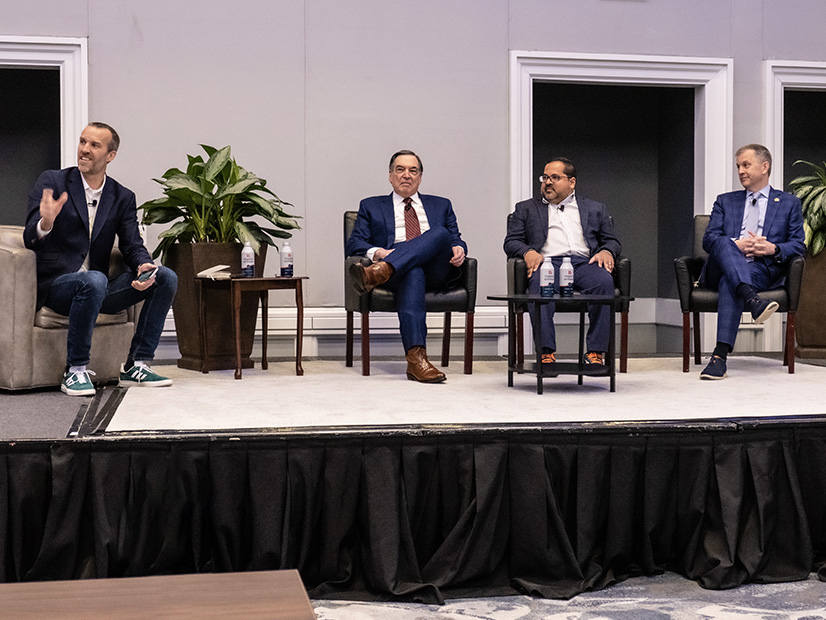
LEESBURG, Va. — FERC has become too politicized and should use its independent authority to move the electricity industry forward, two former commission chairs said Tuesday at an event hosted by aggregation company Voltus in Northern Virginia.
Former Chair Neil Chatterjee, now a senior advisor with Hogan Lovells, said he has developed a relationship over the years with Voltus Chief Regulatory Officer Jon Wellinghoff, who chaired FERC under President Obama, because during his tenure at the agency he looked to build on his predecessor’s work through major orders.
Wellinghoff was the force behind Order 745 on demand response compensation, which became the subject of a U.S. Supreme Court case affirming FERC’s jurisdiction over demand side resources, and Chatterjee helped shepherd through several orders expanding its authority in that area.
“A lot of what ultimately culminated in [orders] 841 and 2222, and 845, was me building upon the work that he had already done,” said Chatterjee. “And that’s how FERC needs to be. It was an independent agency because you actually didn’t know the partisan affiliations of the different commissioners.”
Now articles regularly spell out the political affiliation of the commissioners. (For the record, Chatterjee was a Republican appointee, and Wellinghoff, a Democrat.) Chatterjee argued parties should not matter.
“When it comes to something like the proper functioning of markets, and the oversight and the reliability of the grid, these things should be independent and above politics,” he said.
While Chatterjee got the initial Order 2222 through, many compliance filings are still before FERC. Wellinghoff said he hoped the commission would move those through and ensure that market rules for distributed energy resources are in line with the order.
“I hope that FERC does step up under 2222 — that they do carry out the spirit and intent of what you started there and actually ensure that these distributed resources do have a full opportunity to play in this market,” Wellinghoff said. “Because if they do, the potential is huge.”
Some forecasts put 28 million electric vehicles on U.S. roads by 2030, a figure that could double based on EPA’s recent proposed emissions rules. (See: EPA Releases Emissions Rules Aimed at Boosting EVs.) But even the smaller number means the country’s behind-the-meter battery capacity will exceed its generating capacity, Wellinghoff said.
“It’s going to be available to be used, and we have to effectuate the ability to use that resource,” he said. “FERC is in the trenches on that right now.”
Reason to be Proud
U.S. Rep Sean Casten (D-Ill.), a major supporter of FERC on Capitol Hill, said the commission has plenty of authority to move the needle on energy policy on its own, although it sometimes needs a push from Congress to get going. He has introduced a bill — the REDUCE Act — that would remove the state opt-out for wholesale demand response programs, as well as other bills on transmission, and he wants FERC to set a price on carbon to give zero-carbon assets their proper value on a grid awash in resources that have no marginal costs.
“I think a strong case can be made that FERC has authority, but perhaps not the obligation,” Casten said. “And whether it’s the REDUCE Act or others, we find ourselves in Congress saying, ‘Well, let’s just give you the obligation.’”
Casten argued that FERC is the most important agency for climate policy and said its adoption of wholesale competition, which led to rapid growth in natural gas combined cycle plants and a surge in capacity uprates for existing nuclear plants, was the main reason the industry moved away from coal.
“FERC’s power comes from authority and independence,” Casten said. “And I think FERC is a little bit afraid of its own shadow.”
Casten said the fact that former FERC Chair Richard Glick was denied a renomination hearing after endorsing policies opposed by Senate Energy and Natural Resources Committee Chair Joe Manchin (D-W. Va.) — particularly around the climate impacts of natural gas pipelines — has also put a chill on the agency.
“My view is if you are appointed to a term running an agency as powerful as FERC, or a commissioner on an agency as powerful as FERC, you have five years to tell your grandchildren that ‘you have reason to be proud of me,’’’ Casten said.
Worrying about whether a policy will impact a renomination hearing or offend a particular senator is no way to go about the job, he said.
FERC has been impacted by politics long before Manchin denied Glick a hearing, with Wellinghoff lamenting the fact that “Standard Market Design” for RTOs never got off the launching pad under Chairman Pat Wood during President George W. Bush’s first term.
“It used to drive me nuts at FERC when an order came in from an RTO and the words were different for the same thing,” said Wellinghoff. “It’s like we’re in Europe, you know — PJM speaks Italian and MISO speaks German.”
Wood tried to push through a reform that would have the same market design all around the country, but he was ultimately “run out of town” by powerful utility interests who were opposed to having independent markets, Wellinghoff said.



